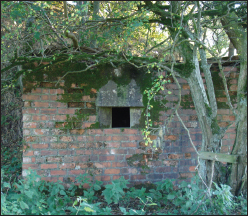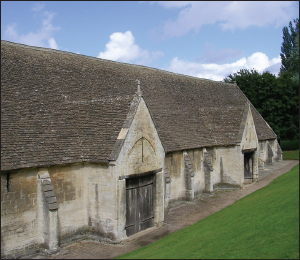The English Village Explained: Britain’s Living History (16 page)
Read The English Village Explained: Britain’s Living History Online
Authors: Trevor Yorke

FIG 8.21 LOWTHER CASTLE, CUMBRIA:
With renewed interest in Britain’s past and patriotism in the wake of the Napoleonic Wars in the early 19th century, castles once again became fashionable. These, however, were mansions and not forts and differ from their medieval counterparts in having large windows, an aesthetically pleasing structure, and fine quality masonry of the same finish throughout
.
The feudal system had always supplied the medieval king with knights and hordes of untrained peasants to fight his battles, although mercenaries had also been used. The first professional fighting force was probably Cromwell’s New Model Army, which played its part in turning round the fortunes of the Parliamentarians in the Civil War. By the 18th century our numerous conflicts with European states were being fought on land and sea by a huge, partly professional force many times larger than any previous English army. To support it, training schools, military ranges and barracks were built, while naval dockyards were either constructed or existing ones expanded, all of this inevitably creating extra demand for produce and employment which would have affected surrounding villages. In the 20th century, during the two World Wars hundreds of new establishments were created, most notably airfields in the south and east of the country. Although these were often abandoned shortly after the war ended or were just used for local aircraft or industry, the remains of runways, Nissen and timber huts can still be found today, while these momentous times live long in the memory of villagers.

FIG 8.22:
A common feature today in fields, along country lanes and close to railways and waterways are Second World War pillboxes, built as a last line of defence close to strategically important local features when the threat of invasion was at its greatest. There are many different shapes and sizes, some with large openings for artillery while others had just holes for guns as in the above example
.
Most medieval villages would have had a mill where the grain produced from the fields and strips could be ground down into flour. The miller had a monopoly, enforced by the lord of the manor, on grinding the peasants’ grain and they were renowned for excessive charging or taking a share for themselves and were generally loathed
as a result. Many villagers kept quern stones (small millstones a foot or so across with a handle) so they could grind small quantities at home for personal use. Early mills were always powered by water wheels, Saxon ones set horizontally, most medieval and later ones vertically, with windmills only appearing in the 13th century (probably introduced into this country by crusader knights who had seen them on the continent).
From the 15th century many water mills were being converted to power fledgling industries like fulling (part of the process of turning wool into cloth)
and later for making paper and cotton. By the 18th century they were no longer humble, timber structures but often large, industrial buildings which would be a vital source of employment in a village (see
Fig 8.32
). Some were also built to pump out mines although these were among the first to be replaced by steam engines. Windmills also developed in their structural form, as first post mills were improved and then superseded by smock and tower mills in which only the top cap rotated above a more stable timber or brick structure. It is these 18th and 19th-century types which you are most likely to see today.

FIG 8.23 LOWER SLAUGHTER, GLOS:
An early 19th-century mill which has retained its water wheel. At sites where the buildings have gone, it is often still possible to find the remains of leats, sluices and mill ponds to reveal where they once stood
.

FIG 8.24 AVONCROFT MUSEUM OF HISTORIC BUILDINGS, WORCS:
Medieval windmills would have been simple post types with the sails and upper parts supported on a vertical post so that they could be turned to face the wind. No medieval mill still stands today but the mounds on which they were erected can be found and are often confused with barrows and castles (check field names for clues). The ones which survive today, as in this restored example, date from the 17th century and later, and have circular structures around the base rather than an earthen mound. Some also had tails which rotated the windmill into the wind. The wooden ‘sails’ you see today are only the frames which supported the actual material sails which would have been drawn across them when in use. Some were also used for pumping water in drainage schemes, most notably in the Fens
.
After the Reformation the building of almshouses to accommodate the old and infirm of the village became the social responsibility of the lord and parishioners instead of the Church, and many villages still retain these distinctive buildings which can date from the late 15th to the 19th century. They are most commonly a long row or courtyard of single-storey cottages in a unifying architectural style, often with matching doors and windows and a plaque declaring the benefactor and the date when it was established (see
Fig 4.10
).
Education for all was not compulsory until the Education Acts of the late 19th century and most schools which are found in villages today will date from the 1870s and 1880s or will be later replacements. Education was patchy before this; the wealthy could send their children off to schools and colleges in the towns and cities while many poorer children might have had some form of rudimentary schooling, but even then it would have been interrupted by the seasonal demands of agriculture. Local benefactors did build some schools in villages, filling the gap left in the mid 16th century by the dissolved monasteries, but they may not necessarily have been welcoming to all members of the community.

FIG 8.25:
Many village schools like this example date from the decades after the 1870 Education Act. These elementary schools taught children the basics up to a maximum age of thirteen, although most left earlier and attendance could be patchy especially at harvest time. The system whereby village children would only receive their education from a single school lasted in many parts up until the Second World War, despite the modern system of primary and secondary education having been phased in from 1926
.
Farmhouses
As yeoman farmers began to appear in the 14th century so they built themselves new houses along the village streets from which they could manage their strips out in the fields. As their income grew, these would often be two-storey, timber-framed buildings standing proudly above the lower hovels of the peasantry around them. When enclosure took place either by agreement early on or by Parliamentary act in the 18th and 19th centuries, there was the opportunity for farmers to relocate their residence to the centre of their new holdings, their old building back in the village often being split up for workers’ cottages. Many of these new farmyards were built with a courtyard around which all the principal buildings were carefully arranged, with pens, stables and a dairy, and in the Victorian period an animal wheel-house or steam engine provided power for machinery, resembling a factory rather than farm.
Among the most enduring symbols of the monastic system are their huge barns, some of which date back to the 13th century. These were used to store the produce from the monastery’s estates, their huge size emphasising the success of their farms, although they are often erroneously referred to as tithe barns. They were built with timber frames, either aisled or with cruck blades supporting the huge sloping roof, with opposing sets of doors between which the threshing – separating of the grain from the stem of the crop – was performed (this area being known as the threshold). These agricultural cathedrals were usually sited near the manor house or grange and it is a credit to their design and construction that they not only remain standing but also, when rediscovered, have often been found still in use.
Smaller versions were built on secular estates, with the grain produced usually stored within the farmhouse due to its value. Later separate granaries were built, small timber-framed buildings set on mushroom-shaped stones or as a room above a cart shed, raised off the ground to keep rodents away from the grain, and limewashed within.

FIG 8.26 LAXTON, NORTHANTS:
This unique village is still surrounded by open fields and strips, with the farmhouses lining its main street as they would have in medieval times
.

